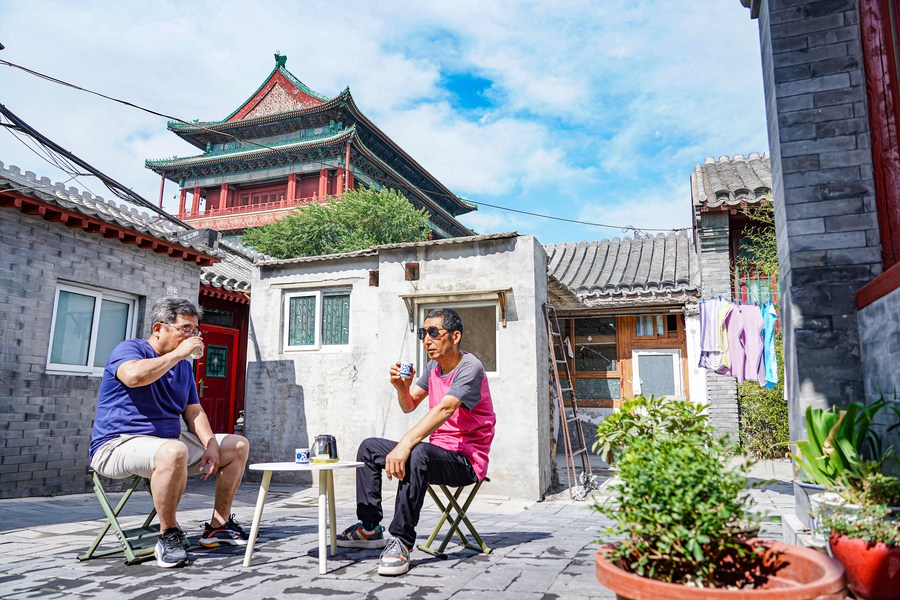Cultural innovation breathes new life into Beijing's hutongs

Locals enjoy tea at their courtyard in a hutong near the Drum Tower and Bell Tower in Beijing, capital of China, June 12, 2023. [Xinhua/Chen Zhonghao]
BEIJING -- Nestled amidst the towering skyscrapers and bustling streets of the Chinese capital Beijing, hutongs hold a special place in the hearts of many residents. Wang Jing is no exception.
For the 48-year-old woman who grew up in hutongs, these narrow alleys lined with traditional courtyards often serve as the backdrop for childhood adventures and close neighborly relations.
"When I came home from school, only to find that nobody was there and I forgot to bring my key, I would do my homework or have a meal at my neighbors' homes," Wang recalled. "We were like one big family."
Hutongs are a type of narrow alley commonly found in northern Chinese cities. Ingrained in the DNA of Beijing's urban development, hutongs have existed for centuries in the city.
There are several theories about the origin of the word "hutong." Some say that the capital's once common residential communities were often built around a communal well, with the phrase "hutong" originating from the Mongolian term for "water well."
In common use, the term may also be applied to other alleys that don't necessarily bear the name, such as those called "xiang" (lane) and "jie" (street).
Wang runs a shop selling cultural and creative products on Yangmeizhu Diagonal Street. She seeks to offer visitors more knowledge about the city's history and traditional culture involving the iconic hutongs.
With an academic background in industrial design, she makes and sells an array of products, ranging from ceramic coasters to postcards and notebooks, with the theme of traditional Chinese culture. Among the top-selling items are fridge magnets based on the signboards commonly found outside stores in Dashilan area in the past.
"Dashilan was once a bustling commercial center. To attract buyers, many shops would hang signboards called 'huangzi' displaying information about their particular business," she said.
For Wang, hutongs not only depict the architectural style and artistic essence of Beijing but also bear witness to the city's historical transformations.
"It's interesting to work in a place that is tinged with nostalgia," Wang told Xinhua. She herself has witnessed the remarkable transformation of these traditional alleys.
She used to pass down the 500-meter-long Yangmeizhu Diagonal Street every day on her way to school. Numerous clotheslines and electrical wires crisscrossed above the narrow alleyway at that time, she recalled.
In recent years, restoration projects have been undertaken to preserve the original charm of the courtyard houses, while efforts to enhance the infrastructure and amenities have improved the quality of life for hutong residents.
Yangmeizhu Diagonal Street has gradually regained its original charm. Today this historical alley is paved with grey bricks, with art studios and miniature museums scattered around old courtyards. Wang's store proudly stands among these cultural gems.
The transformation of the street is part of Beijing's efforts to protect and revitalize its hutongs through cultural innovation.
In 2017, Beijing unveiled a general city plan for 2016 to 2035, underlining the strengthening of historic and cultural building conservation, and strengthening urban characteristics in capital city style, ancient city flair and modern city landscaping.
The general city plan requires the preservation of more than 1,000 hutongs and their names. Hutongs and alleys with traditional Beijing flair will be revived and hutong culture will be developed.
In Shijia hutong in the downtown Dongcheng District, the Shijia Hutong Museum was established. As the city's first public hutong museum, it is dedicated to promoting Beijing hutong culture, enriching the intellectual life of residents, and sustaining a site that evolves with time and presents the living history of hutongs.
Since its completion, the museum has collected old furniture, photos, and other old objects from hutong residents, invited artists to record the sounds of insects and voices in the hutong, and created a permanent exhibition, leaving a collective memory for hutong residents.
In turn, hutongs are driving the development of Beijing's cultural industries. In 2021, the cultural and related industries in the city's two main clusters of hutongs, Dongcheng and Xicheng districts, generated revenue of 143.63 billion yuan (about 19.82 billion U.S. dollars) and 99.86 billion yuan, respectively.
"Hutongs are a unique feature of Beijing, and preserving hutongs means protecting Beijing's culture," said Liu Yang, an official from Xicheng District.
Her view is echoed by Wang Jing, who believes that hutongs are not only residential communities but also a living cultural icon of the city.
"In Hutongs, people can see, touch and feel a real Beijing, its past and present," she said.
























